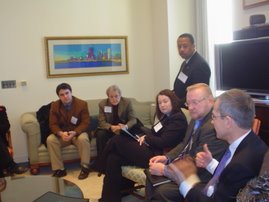TOPIC - Sustainable Design
Draft Update 17 October 2006
Adopted January 2007
Sunset December 2007
Policy Statement
Sustainability is best defined as “development that meets the needs of the present without compromising the ability of future generations to meet their own needs.” AIA Illinois believes that a healthy environment for all life is important. Architects are uniquely trained to be leaders in integration of design disciplines in ways that mirror the interrelationships of natural ecosystems. Whole-systems thinking is required for sustainable design that solves the needs for human habitation while preserving and enhancing environments that support all life.
Sustainable planning and design is good for the architectural profession from business as well as ethical perspectives. AIA Illinois believes that failure to take the necessary steps to achieve a sustainable future is not a viable option. Key policy issue areas to meet this challenge include energy consumption, conservation of material resources, healthy buildings, historic preservation, affordable housing, efficient use of infrastructure, transportation choice, and sense of place.
In order to succeed in this initiative we must reach beyond our traditional purview and develop partnerships with other organizations for pursuing sustainable development.
Issue 1 - Energy Consumption/Production
Issue
Operation of buildings is the greatest source of energy consumption and related green-house emissions in the world.
Position
AIA Illinois supports policies that provide for continued aggressive energy conservation, including building modifications to promote more efficient energy use and promoting environmentally sound production of alternative energy sources.
Issue 2 - Conservation of Material Resources
Issue
Building construction accounts for 40% of the consumption of raw materials, as well as approximately 40% of the total solid waste stream.
Position
AIA Illinois supports policies that reduce the consumption of our natural resources. Recycled and rapidly renewable materials should be incorporated into building designs and construction waste should be managed to allow this material to be recycled and directed away from landfills.
Issue 3 - Healthier Buildings
Issue
Americans spend an average of 90% of their time indoors, where levels of pollutants reach up to 100 times-higher than outdoor levels.
Position
AIA Illinois supports policies that promote healthier indoor environments. Improvement in indoor air quality has a positive impact on the health and productivity of the occupants of the building. Building materials should be selected that contain the lowest quantities of toxic chemical and volatile organic compounds available.
Issue 4 – Historic Preservation
Issue
Many historically significant structures and places are being razed to make way for new developments. Books like Lost Chicago are filled with pictures of magnificent buildings that no longer exist. Demolished buildings don’t simply leave memories behind, the embodied energy they contain is lost as well.
Position
AIA Illinois supports policies that provide incentives to retain and revitalize existing structures and places that have high architectural and cultural value. These places provide an important benchmark for understanding who we are and show where we came from.
Issue 5 – Affordable Housing
Issue
The real cost of housing isn’t limited to a rent or mortgage payment, it also includes utility costs, transportation and commuting expenses, access to essential goods and services and many other factors that impact affordability. Communities without housing for their teachers, police officers, fire fighters, nurses, laborers, and service employees impact not only those workers and their families but growth patterns, traffic congestion and a host of other unintended but avoidable consequences.
Position
AIA Illinois supports incentives for development of affordable housing and related infrastructure. This includes innovation in planning, design and construction techniques that seek to reduce construction costs while providing sense of community and maintaining standards for building safety.
Issue 6 – Efficient Use of Infrastructure
Issue
The infrastructure cost of building in undeveloped sites is estimated to be approximately $50,000 per dwelling unit. This compares with $5,000 per dwelling unit at locations that are already served by basic utility, roadway, school and government facilities infrastructure.
Position
AIA Illinois supports policies that redirect subsidies for “greenfield” sites to areas that are already served by existing infrastructure. We cannot afford to use our limited tax dollars to underwrite sprawl.
Issue 7 – Transportation Choice
Issue
Approximately 89% of all trips in the U.S. are made in cars. A recent study by the Centers for Disease Control found that neighborhood and transportation planning affected obesity rates, asthma and other health concerns.
Position
AIA Illinois supports government policies and funding decisions that promote a wider range of viable transportation choices including walking, biking, buses, and trains, especially for the young and elderly who cannot drive. Each of these travel options promotes more efficient use of fossil fuel energy than cars. Increased transportation choice can be achieved through community planning with close destination proximity connected by pathways or transit lines.
Issue 8 – Sense of Place
Issue
Many developing communities have little or no sense of “there” there. Places where people live, work, play and worship are enhanced by a feeling of character, substance and uniqueness.
Position
AIA Illinois supports mixed-use pedestrian/transit oriented development that reduces dependence on roadway infrastructure and increases sense of place in the community. Distinctive, compact communities with good access to open spaces allow for a sustainable, high quality of life for their residents.
References:
http://www.aia.org/walkthewalk
http://www.aia.org/susn_rc_default
http://www.aia.org/fiftytofifty
Subscribe to:
Post Comments (Atom)







6 comments:
Historic Preservation is "the management of Change." It is a tool to maintain the existing building fabric, while making educated decisions on when alterations are necessary in order to continue architectural progress. Our built fabric is our history, and through preservation we as architects have the responsibility to enhance our community through the education of how to live and work within our vintage and historic buildings. If we don’t respect our physical environment, who will? Our charge as architects is to design within and around the existing constraints posed by our existing buildings - and allow them to exist for future generations.
Regarding the Affordable Housing issue, the AIA Illinois position should also support restructuring of the funding mechanisms for affordable housing so that energy efficiency and durability are recognized in terms of the life of the building. This may mean that the initial cost is slightly higher, for a longer lasting material or more efficient equipment. As it is stated in the first sentence of the issue, the definition of affordable needs to expand to include the life of the building not be limited to its first cost, the position could be stronger in this regard.
Further elaborating on the issue of Affordable Housing (among others), it would be good to add text to each sub-position statement to cross-reference between sustainable categories. This will in turn reinforce the interrelatedness of the overarching position (sustainable design), making for a more compelling case. Specifically related to affordable housing, sustainable/high performance attributes, first costs vs. life cycle costs, transit oriented development, embodied energy of existing structures, etc. need to be acknowledged as key components of making housing affordable.
What happens when this policy "sunsets" in December of 2007?
In regards to Historic Preservation - what has been said thus far by AIA IL seems to be lacking in terms of words like "preserve" and protect. Perhaps this is because it has been addressed within the Sustainable Design statement rather then given a position of its own.
Post a Comment